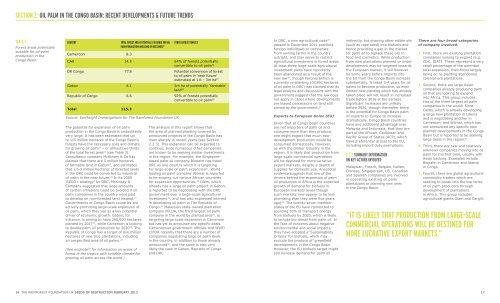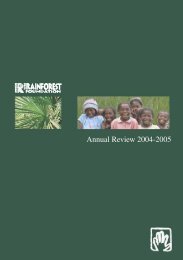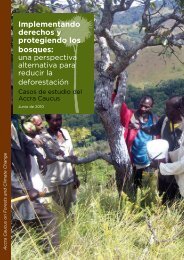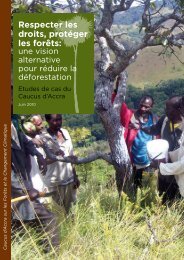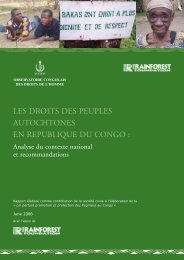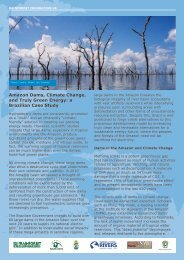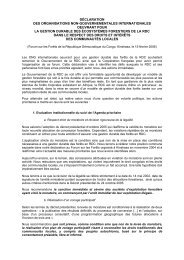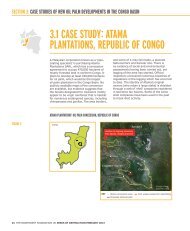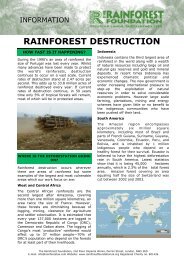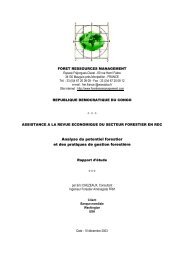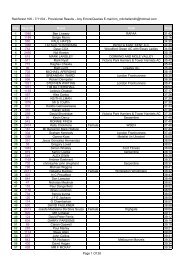Seeds of Destruction - Rainforest Foundation UK
Seeds of Destruction - Rainforest Foundation UK
Seeds of Destruction - Rainforest Foundation UK
You also want an ePaper? Increase the reach of your titles
YUMPU automatically turns print PDFs into web optimized ePapers that Google loves.
SECTION 2: OIL PALM IN THE CONGO BASIN: RECENT DEVELOPMENTS & FUTURE TRENDS<br />
TABLE 3<br />
Forest areas potentially<br />
suitable for oil-palm<br />
production in the<br />
Congo Basin.<br />
COUNTRY<br />
Cameroon 8.3<br />
The potential for expansion <strong>of</strong> oil palm<br />
production in the Congo Basin is undoubtedly<br />
very large. It has been estimated that up<br />
to 115 million hectares <strong>of</strong> the Congo Basin’s<br />
forests have the necessary soils and climate<br />
for growing oil palm 17 – or almost two thirds<br />
<strong>of</strong> the total forest area 18 (see Table 3).<br />
Consultancy company McKinsey & Co has<br />
claimed that there are 5 million hectares<br />
<strong>of</strong> farmable land in Gabon 19 , and estimates<br />
that 1.6-3 million hectares <strong>of</strong> forested lands<br />
in the DRC could be converted to industrial<br />
oil palm in the near future. 20 In its 2009<br />
‘REDD+ strategy’ for DRC, McKinsey &<br />
Company suggested that large amounts<br />
<strong>of</strong> carbon emissions could be avoided if oil<br />
palm companies in the country were paid<br />
to develop on non-forested land instead. 21<br />
Governments <strong>of</strong> Congo Basin countries are<br />
actively promoting large-scale expansion <strong>of</strong><br />
oil palm, which they see as a key potential<br />
driver <strong>of</strong> economic growth. Gabon, for<br />
instance, is aiming to have 200,000 hectares<br />
planted by 2017 22 , while Cameroon is looking<br />
to double palm oil production by 2020 23 . The<br />
Republic <strong>of</strong> Congo has a target <strong>of</strong> one million<br />
hectares <strong>of</strong> new tree plantations, including<br />
an unspecified area <strong>of</strong> oil palms. 24<br />
(See endnote 30 for information on areas <strong>of</strong><br />
forest in the tropics with suitable climate for<br />
growing oil palm across the world.)<br />
TOTAL FOREST AREA POTENTIALLY SUITABLE FOR OIL<br />
PALM PRODUCTION (MILLIONS OF HECTARES) 25<br />
OTHER DATA/ESTIMATES<br />
CAR 14.5 64% <strong>of</strong> forests potentially<br />
convertible to oil palm 26<br />
DR Congo 77.8 Potential conversion <strong>of</strong> forest<br />
to oil palm in ‘near future’<br />
estimated at 1.6 – 3m ha 27<br />
Gabon 8.1 5m ha <strong>of</strong> potentially ‘farmable’<br />
land 28<br />
Republic <strong>of</strong> Congo 6.6 92% <strong>of</strong> forests potentially<br />
convertible to oil palm 29<br />
Total 115.3<br />
Source: Earthsight Investigations for The <strong>Rainforest</strong> <strong>Foundation</strong> <strong>UK</strong><br />
The analysis in this report shows that<br />
the area <strong>of</strong> planned planting covered by<br />
announced projects in the Congo Basin has<br />
risen sharply in recent years (see Section<br />
2.2.3). This expansion can be expected to<br />
continue, since numerous other companies<br />
are known to be seeking similar investments<br />
in the region. For example, the Singaporebased<br />
palm oil company Biopalm has listed<br />
DRC as one country which it is targeting<br />
for large-scale oil palm expansion 31 . Worldleading<br />
oil palm company Wilmar is reported<br />
to be scoping out various African countries<br />
for expansion opportunities. 32 Olam, which<br />
already has a large oil palm project in Gabon,<br />
is reported to be negotiating with the DRC<br />
government over a large-scale agricultural<br />
investment 33 , and has also expressed interest<br />
in developing oil palm in The Republic <strong>of</strong><br />
Congo. 34 Malaysian state-owned plantation<br />
company FELDA, the third largest oil palm<br />
company in the world by planted area 35 , is<br />
targeting large scale expansion in Cameroon<br />
but has yet to announce any specific deals.<br />
Cameroonian government <strong>of</strong>ficials told WWF/<br />
CIFOR recently that there are a number <strong>of</strong><br />
companies negotiating large oil palm deals<br />
in the country, in addition to those already<br />
announced 36 , and the same is also very<br />
likely the case in Gabon, Republic <strong>of</strong> Congo<br />
and DRC.<br />
In DRC, a new agricultural code 37<br />
passed in December 2011 prohibits<br />
foreign individuals or companies<br />
from owning farms in the country<br />
outright, and may serve to restrict<br />
agricultural investment in forest areas.<br />
At least three large-scale agricultural<br />
investment plans have reportedly<br />
been abandoned as a result <strong>of</strong> the<br />
new law 38 , though Feronia (which is<br />
currently re-planting 107,892 hectares<br />
<strong>of</strong> oil palm in DRC) has claimed that its<br />
legal analysis and discussions with the<br />
government suggest that the law does<br />
not apply in cases where developments<br />
are leased concessions on land still<br />
owned by the government. 39<br />
Exports to European Union (EU)<br />
Given that all Congo Basin countries<br />
are net importers <strong>of</strong> palm oil and<br />
consume more than they produce,<br />
one might expect that much new<br />
development production would be<br />
consumed domestically. However,<br />
as with the timber industry in the<br />
region, it is likely that production from<br />
large-scale commercial operations<br />
will be destined for more lucrative<br />
export markets, despite a dearth <strong>of</strong><br />
supplies for domestic use. Anecdotal<br />
evidence suggests that one <strong>of</strong> the<br />
drivers behind the expansion <strong>of</strong> palm<br />
oil production in Africa is the expected<br />
growth <strong>of</strong> demand for bi<strong>of</strong>uels in<br />
European markets (even though<br />
such markets now appear to be less<br />
promising than they were five years<br />
ago) 40 . The twenty-seven member<br />
states <strong>of</strong> the EU have committed to<br />
sourcing 10% <strong>of</strong> transport energy<br />
from bi<strong>of</strong>uels by 2020, which is likely<br />
to include bio-diesel from palm oil. In<br />
the face <strong>of</strong> concerns about negative<br />
environmental and social impacts,<br />
they have adopted a ‘Sustainability<br />
Criteria’ for bi<strong>of</strong>uels, which may<br />
exclude the produce <strong>of</strong> ‘greenfield’<br />
developments in the Congo Basin.<br />
However, the EU bi<strong>of</strong>uels target might<br />
still increase demand for palm oil<br />
indirectly, but drawing other edible oils<br />
(such as rape seed) into bi<strong>of</strong>uels and<br />
hence providing a gap in the market<br />
for palm oil to replace these oils in<br />
food and cosmetics. While production<br />
from new plantations planned or under<br />
development may be targeted towards<br />
the European market, it will however<br />
be some years before imports into<br />
the EU from the Congo Basin increase<br />
substantially. It takes 3-4 years for oil<br />
palms to become productive, so even<br />
limited new planting which has already<br />
taken place will not result in increased<br />
trade before 2016 at the earliest.<br />
Significant increases are unlikely<br />
before 2020, though thereafter there<br />
is the potential for Congo Basin palm<br />
oil exports to Europe to increase<br />
dramatically. Congo Basin countries<br />
have one additional advantage over<br />
Malaysia and Indonesia, that they are<br />
part <strong>of</strong> the African, Caribbean and<br />
Pacific Group <strong>of</strong> States (ACP), which<br />
have preferential access to the EU,<br />
including import duty exemptions.<br />
2.2.2 SUMMARY INFORMATION<br />
ON KEY ACTORS INVOLVED<br />
Malaysian, French, Belgian, Italian,<br />
Chinese, Singaporean, US, Canadian<br />
and Spanish companies are involved<br />
in operating existing oil palm<br />
plantations or planning new ones<br />
in the Congo Basin.<br />
There are four broad categories<br />
<strong>of</strong> company involved.<br />
1. First, there are existing plantation<br />
companies looking to expand (e.g.<br />
CDC, SIAT). These represent a very<br />
small percentage <strong>of</strong> the potential<br />
total expansion, their focus largely<br />
being on re-planting abandoned<br />
colonial-era plantations.<br />
2. Second, there are large Asian<br />
companies already producing palm<br />
oil that are looking to expand<br />
into Africa. This group includes<br />
two <strong>of</strong> the three largest oil palm<br />
companies in the world: Sime<br />
Darby, which is already developing<br />
a large new plantation in Liberia<br />
and is negotiating another in<br />
Cameroon; and Wilmar, which has<br />
not announced any specific new<br />
planned developments in the Congo<br />
Basin but is reported to be seeking<br />
large deals in the region. 41<br />
3. Third, there are new and relatively<br />
unknown companies moving into oil<br />
palm for the first time, usually with<br />
Asian backing. Examples include<br />
Biopalm in Cameroon and Atama<br />
in Congo.<br />
4. Fourth, there are global agricultural<br />
commodity traders which are<br />
seeking to break into the top ranks<br />
<strong>of</strong> oil palm producers through<br />
development <strong>of</strong> plantations<br />
in Africa. This group includes<br />
agricultural giants Olam and Cargill.<br />
“It is likely that production from large-scale<br />
commercial operations will be destined for<br />
more lucrative export markets.”<br />
16 THE RAINFOREST FOUNDATION <strong>UK</strong> SEEDS OF DESTRUCTION FEBRUARY 2013 17


